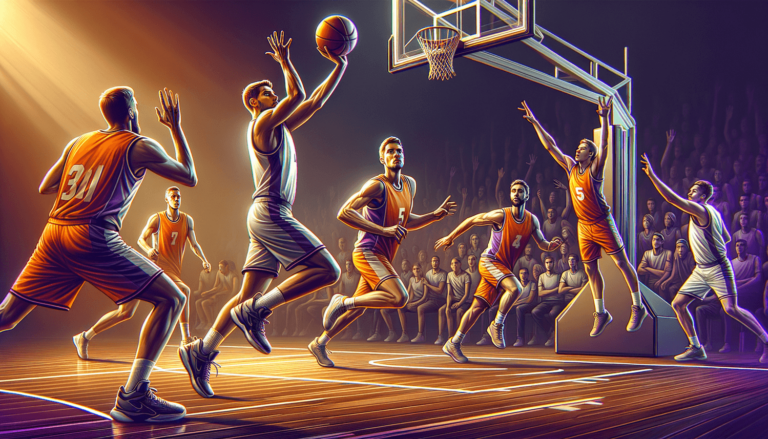
Ever wondered about those swift, intricate and mesmerizing plays that leave defenders scrambling on the basketball court? Well, you’re in for a treat! In this blog post, we’re diving into the world of the pick and pop – a highly effective offensive strategy that, when executed correctly, can create high-percentage scoring opportunities. Suitable for basketball fanatics and curious newbies alike, we’ll break down the Xs and Os of this deceptively simple tactic, learning its nuts and bolts, examining its role in the modern game, and exploring how some of NBA’s finest have mastered it. So, lace up your sneakers and get ready to enrich your hoops knowledge with this exciting read!
What’s a Pick and Pop in Basketball?
A pick and pop in basketball is an offensive play where a player (usually a forward or center) sets a screen for their teammate (usually a guard), then moves into an open space on the court to receive a pass for a jump shot. This action creates separation and forces the defenders to make a quick decision, often resulting in a high-percentage scoring opportunity.
The Anatomy of a Pick and Pop
Before diving into the nitty-gritty of the pick and pop, let’s first cover some basketball fundamentals. The pick and pop is a variation of a more general basketball play called the pick and roll. Both plays involve two key components: a screen (or “pick”) and the movement of the screener after setting the screen. In the pick and pop, the screener “pops” out to the perimeter for an open jump shot.
In order to better understand the pick and pop, let’s break down the play step by step:
1. Setting the Screen
The play begins with the screener (typically a forward or center) moving towards the ball handler (usually a guard). As the screener approaches, they position themselves in the path of the ball handler’s defender, effectively creating a human barrier. The goal is to enable the ball handler to drive towards the basket or create an open passing lane by obstructing the defender’s movement.
2. The Ball Handler’s Decision
With the screen set, the ball handler has several options. They can either drive towards the basket, take a shot, or pass the ball. The decision hinges on how the defenders choose to adjust and the particular strengths of the offensive players involved.
3. The Pop-Out
After setting the screen, the screener carefully assesses the situation on the court. If they see an opening along the perimeter, they “pop” out, quickly stepping away from their defender and creating distance. This action often catches defenders off-guard and provides the screener with ample space to receive a pass for an open jump shot.
Key Factors for a Successful Pick and Pop
While the pick and pop may sound simple, it requires excellent timing, coordination, and basketball IQ from both the screener and the ball handler. Here are some critical factors that can make or break the play:
Effective Screening
The effectiveness of the pick and pop hinges on the quality of the screen. The screener must make solid contact with the defender, preventing them from easily slipping past. Additionally, the screener should avoid moving or leaning into the defender, as this could result in an offensive foul.
Strong Communication
Establishing clear and concise communication between the ball handler and the screener is vital. Whether verbal or non-verbal, communication cues enable the offensive players to anticipate each other’s movements and create scoring opportunities.
Reading the Defense
A good pick and pop duo must be able to read the defense and make decisions on the fly. The ball handler needs to gauge the defenders’ positioning and spacing to determine whether to drive, shoot, or pass. Similarly, the screener must quickly identify openings along the perimeter and be ready to receive a pass for an open shot.
Variations and Counters to the Pick and Pop
Given its strategic value and prevalence in basketball, it’s no surprise that teams have developed various derivatives and counters to the pick and pop. Here are some popular variations and defensive tactics:
Pick and Roll
As mentioned earlier, the pick and pop is a variant of the more traditional pick and roll. In a pick and roll, the screener rolls towards the basket after setting the screen, seeking a pass for an interior scoring opportunity. Compared to the pick and pop, the pick and roll is more focused on exploiting mismatches and creating high-percentage shots close to the rim.
Pick and Slip
The pick and slip is a clever variation on the pick and pop. In this play, the screener pretends to set a screen before quickly slipping away, heading directly to the perimeter or the basket. This action can catch defenders off-guard, creating open shot opportunities or an easy path to the rim.
Defensive Switches
One common defensive tactic against the pick and pop is switching. When a screen is set, the defenders will quickly swap assignments, covering each other’s offensive player. If executed well, this switch can effectively neutralize the pick and pop play. However, switching can also create mismatches that offensive players can exploit.
Defensive Hedging
Hedging is another defensive response to the pick and pop. In a hedge, the screener’s defender momentarily steps out to impede the ball handler’s progress before quickly recovering to their original assignment. This tactic aims to delay or disrupt the offensive play, buying time for the defenders to recover and adjust.
Fighting Through Screens
A more aggressive defensive approach involves fighting through the screen. In this scenario, the ball handler’s defender works to navigate around the screener, maintaining close contact with the offensive player. This method can be effective, but also leaves the defense vulnerable to smart offensive adjustments.
Notable NBA Pick and Pop Duos
Over the years, several NBA duos have showcased their prowess in executing the pick and pop. Here are a few memorable pairings that have left a lasting mark on basketball history:
John Stockton and Karl Malone
The Utah Jazz legends formed one of the most iconic pick and roll/pop partnerships in NBA history. The pick and pop dynamic between Stockton, a celebrated point guard, and Malone, a dominant power forward, made the Jazz a perennial playoff contender throughout the 1990s.
Steve Nash and Dirk Nowitzki
Before Nowitzki’s MVP days with the Dallas Mavericks, he and Steve Nash formed a formidable pick and pop duo. With Nash’s elite playmaking and Nowitzki’s unique blend of size and shooting, they consistently kept defenders on their toes and revolutionized the power forward position.
Stephen Curry and Draymond Green
On the Golden State Warriors’ path to multiple championships, the dynamic pairing of Curry and Green consistently terrorized defenses with their pick and pop prowess. Curry’s unmatched shooting ability and Green’s versatility as a screener and passer posed matchup nightmares, transforming the Warriors into a modern-day dynasty.
Final Thoughts and Takeaways
From rec league games to the NBA, the pick and pop remains a staple in the ever-evolving world of basketball. While mastery of this play takes time and practice, understanding the intricacies of the pick and pop can elevate anyone’s game, regardless of skill level. As you delve deeper into the world of basketball and study this vital play, keep in mind that good coaching, teamwork, and adaptability are ultimately what will set you apart on the court.
Mastering the Pick and Pop as a Player
For players looking to add the pick and pop to their arsenal, a multi-faceted approach will yield the best results. Here are some key areas to focus on as you improve your pick and pop skills and become a more valuable asset to your team:
Developing a Consistent Jump Shot
Being a reliable perimeter shooter is crucial for the player setting the screen in a pick and pop. Spending time refining your shooting form and practicing jump shots from various spots on the court will make you a more potent threat in pick and pop situations.
Building Strength and Conditioning
Being agile and powerful enough to create separation as the screener takes hard work in the gym. Building strength in your legs, core, and upper body while incorporating agility drills will aid in enhancing your pick and pop performance.
Watching Film and Analyzing Plays
Watching game footage, and analyzing pick and pop plays from successful teams, both at the professional and amateur levels, can help in better understanding the nuances and timing needed for successful execution. That insight will allow you to identify mistakes and habits that could limit your pick and pop effectiveness.
Working with Teammates
To establish excellent chemistry between the screener and ball handler, practicing the pick and pop with teammates in various scenarios is essential. This will enable you to develop trust, understanding, and a rhythm, which will translate to success in game situations.
Coaching and Utilizing the Pick and Pop
Coaches play a pivotal role in effectively incorporating the pick and pop into their team’s offensive repertoire. We have outlined some strategies that coaches can use to maximize the benefits of this play:
Identifying the Right Player Combinations
One of the first steps in successfully executing the pick and pop is identifying the right pair of players. Generally, one needs a quick, intelligent ball handler and a big man with reliable shooting skills from the perimeter. Assessing your roster and finding players that complement each other will lead to better results on the court.
Implementing Drills and Practice Scenarios
Running drills focused on pick and pop execution, and simulating the scenarios with defenders or dummy obstacles, will help players understand the complexities of the play. By practicing various situations under different defensive pressures, players will boost their confidence in handling in-game challenges.
Analyzing Weaknesses in Opposing Defenses
Scouting opponents’ defenses to identify patterns, tendencies, and weaknesses will enable a coach to exploit the pick and pop strategy more effectively. Gaining an understanding of how opposing teams defend the pick and pop can help you prepare your players to adapt and seize opportunities.
Reinforcing Fundamentals and Coaching Points
Lastly, continuously emphasizing fundamental elements such as screening, communication, decision-making, timing, and shooting form will greatly increase a team’s chances of success with the pick and pop play. Encouraging players to be critical thinkers on the court while maintaining this strong focus on fundamentals will aid in fostering a well-rounded team.
Frequently Asked Questions
In this section, we address some of the most frequently asked questions about the pick and pop play, and provide concise answers to help expand your understanding of this fundamental basketball strategy.
1. What’s the difference between a pick and pop and a pick and roll?
In a pick and pop, the screener moves away from the basket after setting the screen, positioning themselves for a jump shot. In a pick and roll, the screener rolls towards the basket after setting the screen, looking for a pass near the rim.
2. Who should be the screener in a pick and pop?
The screener should ideally be a forward or center with a reliable jump shot, capable of effectively setting screens and creating space on the perimeter for open shots.
3. Can a smaller player set a screen in the pick and pop?
Yes, smaller players can set screens, but their success often hinges on factors such as quickness, positioning, and the ability to read the defense.
4. How can players improve their pick and pop skills?
Players can improve by working on their shooting accuracy, strength and conditioning, watching film to learn from successful duos, and practicing the play with teammates.
5. What are some common defensive tactics against the pick and pop?
Common defensive tactics include switching, hedging, and fighting through screens to disrupt the play and recover defensive positions.
6. How important is communication in a successful pick and pop?
Communication is crucial, as it allows the offensive players to anticipate each other’s movements, create scoring opportunities, and counter defensive adjustments.
7. Can the pick and pop work in isolation plays?
Yes, the pick and pop can be effective in isolation plays, as it can create one-on-one mismatches and exploit the defenders’ lack of help defense.
8. Are there any other variations of the pick and pop?
Yes, some variations include the pick and slip and the blending of the pick and roll with the pick and pop, changing the screener’s actions based on the defensive response.
9. How has the pick and pop evolved in modern basketball?
With the rise of versatile big men who possess shooting skills, the pick and pop has adapted to focus on exploiting mismatches, creating open three-point shots, and incorporating the play into fast-paced offensive schemes.
10. Can a team’s offensive system be built around the pick and pop?
While the pick and pop can be a fundamental component of an offense, most teams use it as one of several tactical options to create variety and unpredictability in their offensive strategies.
11. Is the pick and pop solely an NBA tactic?
No, the pick and pop is a common play used in various professional leagues, college basketball, and recreational leagues around the world.
12. How can coaches better incorporate the pick and pop in their team strategy?
Coaches can identify the right player combinations, implement drills and practice scenarios, analyze opponents’ defenses, and emphasize fundamentals to enhance their team’s pick and pop execution.
13. Are there any specific basketball shoes that aid in executing the pick and pop?
While no specific basketball shoes are designed solely for the pick and pop, players should prioritize shoes that offer stability, support, and responsiveness to enhance their overall performance in various offensive plays, including the pick and pop.
Featured Posts
- No pillar pages found.





